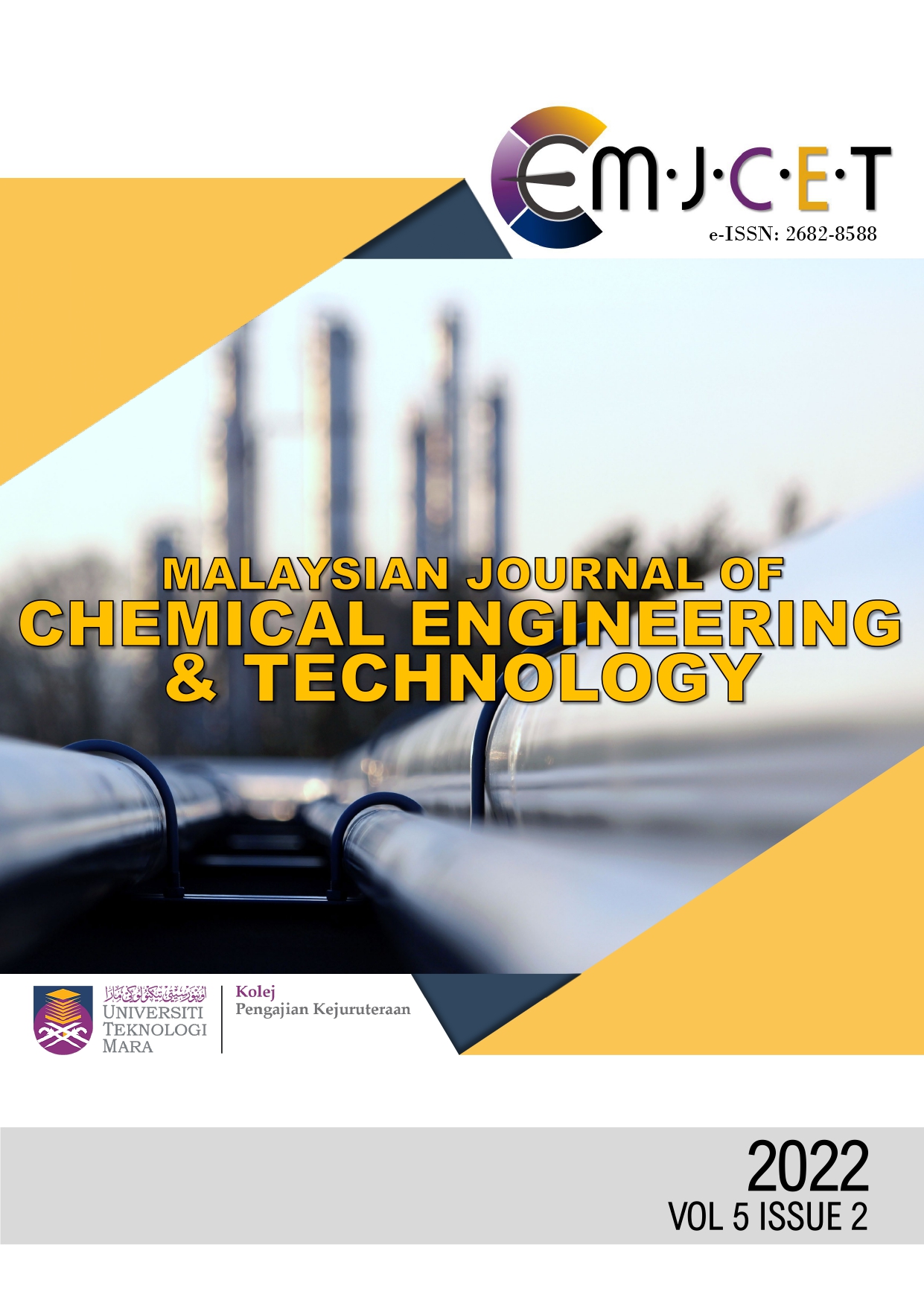Extraction of essential oil from kaffir lime (Citrus hystrix) leaves using microwave-assisted extraction
DOI:
https://doi.org/10.24191/mjcet.v5i2.18996Keywords:
Kaffir lime, Essential oils, Microwave-assisted, Extraction, Yield, OptimisationAbstract
Citrus hystrix DC or normally known as kaffir lime is a citrus species from the Rutaceae family with valuable properties that have attracted the interest of the public. Not only that but the leaves and fruits of the kaffir lime also have a diverse range of essential oils and are therefore used for essential oils extraction. The potential for the commercialisation of kaffir lime essential oil on a large scale in the industry remains a challenge due to the low yield of essential oils produced by conventional methods. In this study, microwave-assisted extraction (MAE) has been chosen as an excellent alternative for essential oil extraction to replace conventional industrial methods. The objectives of this study were to identify the optimum particle size, extraction time, and percentage of co-solvent used for obtaining high extraction oils yield and analyse the volatile compounds of extracted kaffir lime essential oils by using gas chromatography-mass spectrum (GC-MS) analysis. Throughout the extraction, the mass of the sample and power in the MAE process remains constant at 6.0 ± 0.003 g and 600 W, respectively. Therefore, the optimisation of the particle size (400–600 μm), percentage of ethanol (10–20%), and extraction time (5–15 min) were made in this study by using Response Surface Methodology (RSM) to achieve the high quality of essential oils. The mathematical models proposed for the study are the quadratic model for both extraction yield and mass of fatty acid recovered and the two-factor interaction for the mass of ester recovered. The optimum essential oil yield was determined as the particle size is 400 μm, extraction time of 14.95 min, and percentage of ethanol is 14.07% resulting in a yield of 23.54%. The GC-MS analysis resulted in the identification of almost 94 compounds for each of the samples. The identified major compounds from kaffir lime leaf oils were esters and followed by fatty acids.
References
Grand View Research (2020). Essential Oils Market Size, Share & Trends Analysis Report by Application (Food & Beverages, Spa & Relaxation), By Product (Orange, Peppermint), By Sales Channel, and Segemnet Forecasts, 2020-2027. https://www.grandviewresearch.com/industry-analysis/essential-oils-market
Che Radzi, N., Mohd Kamaruzaman, M. F., Mustapa, A. N., & Che Yunus, M. A. (2020). Extraction of Essential Oil from Indigenous Herb Physalis angulata Linn using Microwave Assisted Extraction. Journal of Advanced Research in Fluid Mechanics and Thermal Sciences, 72(1), 138–147. https://doi.org/10.37934/arfmts.72.1.138147
Dejkajorn, C., Suttiarporn, P., Sukkathanyawat, H., Wichianwat, K., Sriphan, S., & Srisurat, T. (2021). Optimization of Microwave-Assisted Extraction of Residual Soybean Oil from Spent Bleaching Earth. E3S Web of Conferences, 302, 01009. https://doi.org/10.1051/e3sconf/202130201009
Kusuma, H. S., & Mahfud, M. (2015). Box-Behnken design for investigation of microwave-assisted extraction of patchouli oil. AIP Conference Proceedings. https://doi.org/10.1063/1.4938350
Llompart, M., Garcia-Jares, C., Celeiro, M., & Dagnac, T. (2019). Extraction | Microwave-Assisted Extraction. In P. Worsfold, C. Poole, A. Townshend & M. Miró (Eds.), Encyclopedia of Analytical Science (3rd ed, pp. 67-77). Oxford: Academic Press. https://doi.org/10.1016/b978-0-12-409547-2.14442-7
Loh, S., Man, Y., Tan, C., Osman, A., & Hamid, N. (2005). Process optimisation of encapsulated pandan (Pandanus amaryllifolius) Powder Using Spray-drying Method. Journal of the Science of Food and Agriculture, 85, 1999–2004. https://doi.org/10.1002/jsfa.2169
Marr, A. G., & Ingraham, J. L. (1962). Effect Of Temperature On The Composition Of Fatty Acids In Escherichia Coli. Journal of Bacteriology, 84(6), 1260–1267. https://doi.org/10.1128/jb.84.6.1260-1267.1962
Md Othman, S., Hassan, M., Nahar, L., Basar, N., Jamil, S., & Sarker, S. (2016). Essential Oils from the Malaysian Citrus (Rutaceae) Medicinal Plants. Medicines, 3(2), 13. https://doi.org/10.3390/medicines3020013
Mohammad, N., & Baharun, R. B. (2017, August 1). Intention to Purchase Organic Personal Care Product. Advanced Science Letters, 23(8), 7367–7369. https://doi.org/10.1166/asl.2017.9476
Noor, A., Ramlan, A., & Rosnani, H. (2018). Optimisation of essential oil yield and zerumbone content in zingiber zerumbet extract using hydrodistillation process. Chemical engineering transactions, 63, 595–600. https://doi.org/10.3303/CET1863100
Quyen, N. T., Ngan, T., Phong, H., Hien, T., & Dung, L. (2020). Extraction of Kaffir Lime (Citrus hystrix DC.) essential oil by steam distillation and evaluation of chemical constituents. IOP Conference Series: Materials Science and Engineering, 991(1), 012015. doi:10.1088/1757-899X/991/1/012015
Servi, H., Eren Keskin, B., Çelik, S., Budak, M., & Kababıyık, B. (2018). Essential Oil and Fatty Acid Composition of Endemic Gypsophila laricina Schreb. from Turkey. Turkish Journal of Pharmaceutical Sciences, 16(2), 220. https://doi.org/10.4274/tjps.49140
Suresh, A., Velusamy, S., Ayyasamy, S., & Rathinasamy, M. (2020). Techniques for essential oil extraction from kaffir lime and its application in health care products-A review. Flavour and Fragrance Journal, 36(1), 5–21. https://doi.org/10.1002/ffj.3626
Tran, T.H., Nguyen, H.H., Nguyen, D.C., Nguyen, T.Q., Tan, H., Nhan, L.T., Nguyen, D.H., Tran, L.D., Do, S.T., & Nguyen, T.D. (2018). Optimization of Microwave-Assisted Extraction of Essential Oil from Vietnamese Basil (Ocimum basilicum L.) Using Response Surface Methodology. Processes, 6(11), 206. https://doi.org/10.3390/pr6110206
Zielińska-Błajet, M., & Feder-Kubis, J. (2020). Monoterpenes and Their Derivatives—Recent Development in Biological and Medical Applications. International Journal of Molecular Sciences, 21(19), 7078. https://doi.org/10.3390/ijms21197078
Downloads
Published
How to Cite
Issue
Section
License

This work is licensed under a Creative Commons Attribution-ShareAlike 4.0 International License.










